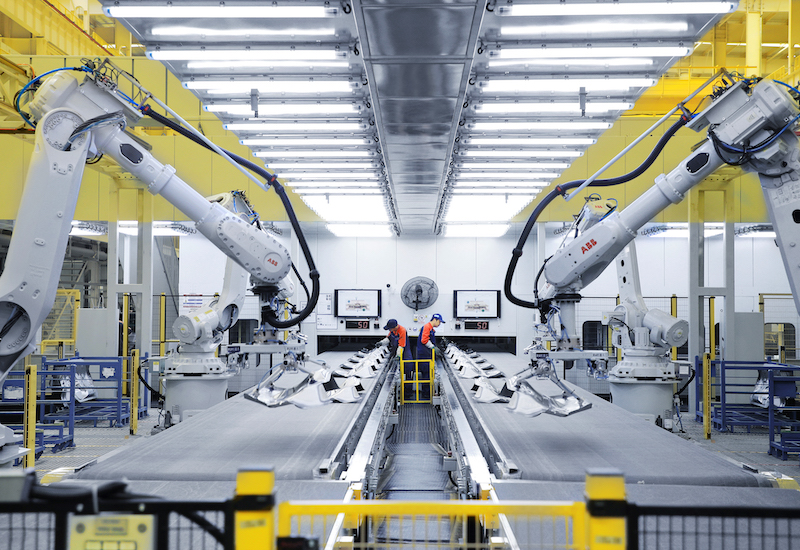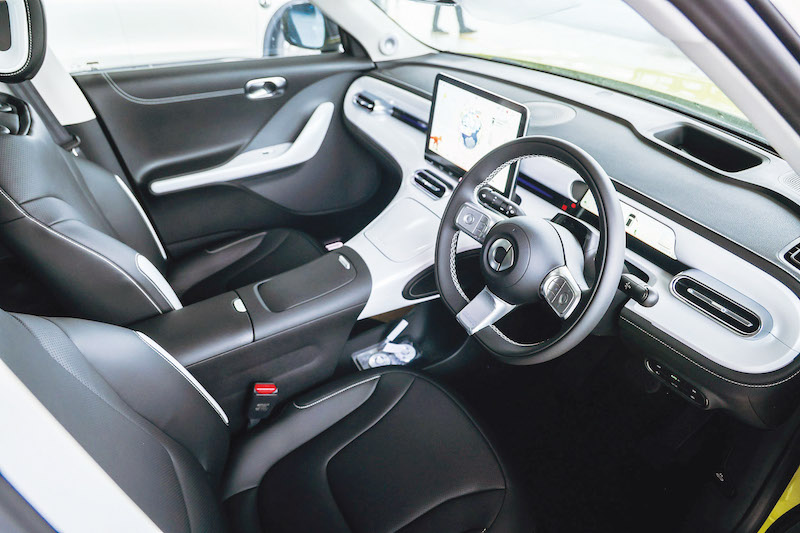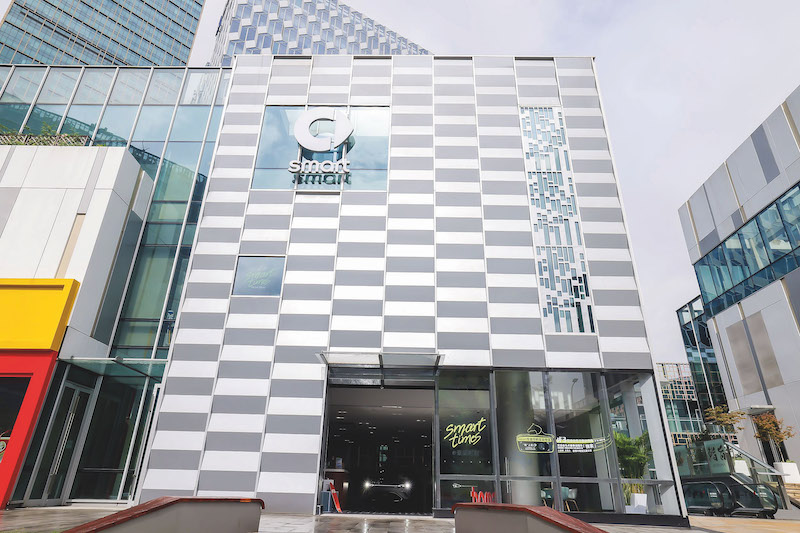
The new Smart is not the oddball ride as you know it (All photos: Smart automobile)
The Smart car was put on Earth 25 years ago to be titchy. The person who manoeuvred this wacky two-seater ForTwo was fun at parties, unabashed about taking up big parking spots, and did not give a hoot about offering anybody a lift. In Europe, the pint-sized runabout was an easy solution to narrow, congested streets and astronomical gas prices. But it did not take long for drivers to realise its vulnerability on the highways, the fact that they had more than just one friend or its puny size at just 2.5m in length that made them go, “Where is the rest of it?”.
Envisaged as a prototype for the future that was about to arrive but never did, the brand conceived from the alliance of Daimler-Benz and Swatch ran up financial losses until the Swiss watchmaker called time on it.
Tiny cars that make it big may be an aphorism with a disputed past but technology progresses in a way where evolution sometimes favours the small. This was a philosophy Nicolas Hayek, co-founder and former CEO of Swatch, first subscribed to when he inked a deal with Daimler-Benz chairman Helmut Werner in 1994 to produce a car — a Swatchmobile, to be precise — that was as customisable as its watches. The name did not stick, but Smart, which stood for Swatch Mercedes Art, became a catchy acronym that went on to clock milestones for the unusual partnership.
Alas, the alliterative qualities of mini and mighty became increasingly difficult to combine in a two- or four-seat tiddler at a time when space economy was highly prized and prices at the pumps sapped automotive sales. But interest to reintroduce Smart cars to the market gained momentum in March 2019 when Daimler AG (now Mercedes-Benz Group AG) and Chinese automaker Zhejiang Geely Holding Group (which also owns Lotus and Volvo) agreed to create a joint venture in China to transform the compact city car into a global all-electric brand. This was the first major move born in the wake of Geely chairman and tycoon Li Shufu’s acquisition of nearly 10% of Daimler shares in 2018, making him the largest shareholder in the maker of Mercedes-Benz luxury vehicles then.
smart_factory_in_xian.jpg

No longer moored in the past when bare bones “econoboxes” plagued urban customers seeking greener options, Smart has made inroads into China, which elbowed out Japan to be the world’s largest exporter of cars recently, chiefly driven by a soaring demand for electric vehicles (EVs). The ForTwo was formerly built by Daimler at its Hambach plant in France, but all Smart EVs are now produced at Geely’s Automotive Manufacturing Base in Xi’an, less than an hour’s drive from the museum of the famed Terracotta Army, built by Emperor Qin Shihuang in the third century BC. The north-central ancient city, which means “western peace” in the Shaanxi Province, had also seen the likes of Marco Polo during his Silk Road journey and the proliferation of Islamic culture and bustling Muslim quarters.
Spanning 2,260 acres, the Xi’an factory constructed with a total investment of RMB7.8 billion is Geely Group’s largest in terms of land area and most advanced project to date. Visiting the space fitted with state-of-the-art 4.0 industry technology was not unlike touring the temples of German automaking as this production stronghold boasts four expansive workshops: stamping, welding, painting and assembling — all while integrating digitalisation, automation and a manufacturing system in full compliance with European Union standards. It was just last year that the factory earned the distinction of being the first Chinese automobile production facility to be awarded a zero-carbon certification, setting an industry benchmark for carbon neutrality commitments and sustainable development.
extra_factory_pic.jpg

Equipped with a 51MW super photovoltaic power generation system, which amounts to 53.76 million kWh annually, the factory is able to reduce emissions, with a knock-on effect equivalent to planting 3,196ha of forest every year. Headquartered in Hangzhou Bay, Ningbo, the carmaker has aimed for at least 55% of the electricity produced at the Xi’an factory to be supplied to the local power grid in the near future.
And what about the cars? It is crucial to note that the new generation of pure-electric Smart vehicles is styled by the Mercedes-Benz global design team, while the engineering and development of new models are spearheaded by Geely’s R&D network. But critics have begun lamenting the diluted Mercedes connection in the #1 SUV (pronounced “Hashtag One”) and the dearth of innovation that used to characterise the nameplate’s funky and flashy persona. Apart from the new, sportier SUV coupé #3, whose makeup resonates more with Mercedes’ premium technological hallmarks and visual language, one may wonder if the upgraded line-up is a derivation of the iconic Smart ForTwo after all.
smart_interior.jpg

A chance behind the wheel would have offered a better insight into the EVs that sit on Geely’s Sustainable Electric Architecture (its SEA2 platform is also shared with the Zeekr X and Volvo EX30). But taking a back seat in the #1 while being driven through a stress test with simulated conditions on the road also allowed a quick scrutiny into Smart’s rendition of the Stuttgart template, from the physical sturdiness of the body to the cabin teeming with features such as a 12.8in touchscreen control panel, Qi wireless charging, a 13-speaker 640W sound system by Beats and a Panoramic Halo Roof. Pedigree notwithstanding, the new Smart with ample legroom scooted around capably, further proving that it does not exist in the market just to make up the numbers.
Like most automakers, Smart is demystifying the electric car trend without the hard sell of a staid showroom. Should you stop by Shanghai for a business meeting or a getaway, its new three-floor brand centre with an on-site café, located in commercial epicentre Lujiazui along the Huangpu River, is an opportunity to sample a sliver of the Smart lifestyle without trekking to Xi’an.
The response to Smart’s arrival in Malaysia has remained optimistic, especially after Proton Holdings Bhd signed a new memorandum of agreement with Smart Automobile in September that will see both parties studying the feasibility of assembling the vehicles at the national carmaker’s
Tanjung Malim Plant. Proton’s subsidiary Pro-Net was appointed the distributor for the brand in Malaysia and Thailand in 2022.
shanghai_brand_centre.jpg

At the time of print, the first batch of #1 had already arrived on our shores and would be delivered to customers immediately upon launching in the fourth quarter. All three variants of it — Pro, Premium and the high-performance Brabus — are available for booking with an estimated price of between RM200,000 and RM250,000.
Will this youthful EV compensate for the fact that you are nipping around town in what is effectively a brand crossover built on a borrowed platform? It may not display enough of its predecessors’ DNA to warrant the badge but as a piece of engineering, it is honestly pretty street smart.
Bookings are available through the Hello smartApp with a refundable RM1,000 fee. See here for more details.
This article first appeared on Oct 23, 2023 in The Edge Malaysia.


